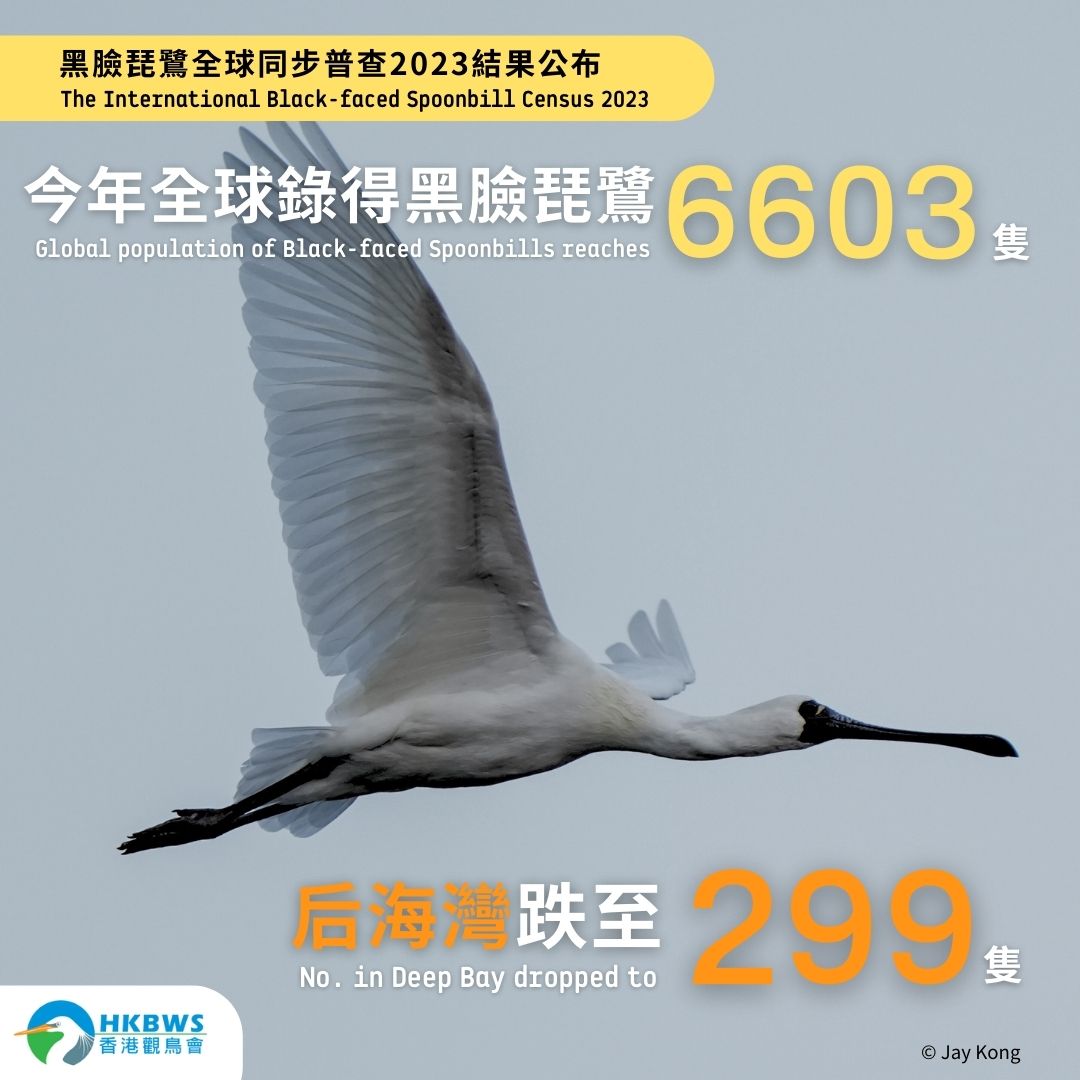后海灣黑臉琵鷺數量下降 籲關注棲息地狀況
由香港觀鳥會統籌的「黑臉琵鷺全球同步普查2023」已於1月6至8日完成。本年度黑臉琵鷺全球數量達6,603隻,為歷年新高,較去年上升7.2%,增加了441隻。后海灣(包括香港及深圳)錄得299隻,較去年減少了70隻,下降19%;與2021年相比,亦下降了11%。
黑臉琵鷺全球數量續創新高 台陸韓增日降 后海灣跌近兩成
本年度普查覆蓋全球約130個地點,台灣、中國大陸、韓國的黑臉琵鷺數量錄得主要增長。台灣繼續是最主要棲息地,全球約64%、即4,228隻黑臉琵鷺在該處度冬,按年升幅為10.6%;中國大陸今年錄得1,307隻度冬黑臉琵鷺,接近全球總數兩成,按年升幅為15.1%。此外,韓國的度冬黑臉琵鷺亦錄得增幅,數量為54隻,比去年增加了17隻,按年增幅為45.9%。日本的度冬黑臉琵鷺數量則錄得下降,數量為610隻,比去年減少了73隻,下跌了10.7%。
本年度的調查數據說明了全球黑臉琵鷺的數量有實在增幅,全球數量穩步上升,台灣及中國大陸的數字近年更屢刷新紀錄,反映這些地點可能具備有利更多黑臉琵鷺停留或聚集的條件,譬如棲息地較安全並能提供豐富的食物來源等。至於日本錄得跌幅,專家估計與停棲地點減少及爆發禽流感有關。
今年后海灣黑臉琵鷺的數量為299隻,是過去十年第二低的記錄。數量較去年減少70隻,下跌了19%。后海灣自2010年錄得歷屆普查最多的 462 隻黑臉琵鷺後,多年來未見突破,2016 年起一直維持於300多隻的水平,今年更跌穿300隻,結果令人擔憂。
不能忽視棲息地惡化問題 冀「北都」保育先行
今年黑臉琵鷺在后海灣的數量下跌,是對香港發出的重要警號。黑臉琵鷺主要在后海灣潮間帶泥灘、基圍淺水區、甚至有降水的魚塘覓食。由於米埔內后海灣拉姆薩爾濕地受到較充分的法例保護和管理,這些棲息地狀況相對能得以維持。然而,自然保護區以外的棲息地,卻面臨各種環境威脅,如不果斷採取行動,將來或變得不適合黑臉琵鷺棲息及覓食。
例如,外來紅樹品種海桑入侵,加上紅樹林擴張,令后海灣泥灘面積持續減少,以致黑臉琵鷺可使用的棲息地亦有所減少。此外,后海灣有近三成魚塘濕地及緩衝區土地由地產商囤積或私人持有,這些土地被荒廢及改變用途,令后海灣一帶持續面臨生境質素退化的威脅。若不馬上針對這些棲息地採取更積極的保育及管理行動,恐致失去黑臉琵鷺的重要度冬棲息地。
過去三十年,包括香港等多個城市和國家,為保護黑臉琵鷺,努力推展不同的保育行動,近年總算成功扭轉黑臉琵鷺的跌勢。香港觀鳥會總監余日東先生表示:「當中訂立整全保護法例、長遠保育策略及良好的土地規劃,對恢復全球瀕危物種甚至生物多樣性,尤關重要。」余日東續指出:「《北部都會區發展策略》的保育與規劃將決定后海灣濕地的未來。為保護這片國際重要的濕地生態完整,《北部都會區》有必要遵守『濕地保育區』及『濕地緩衝區』的保護防線。濕地保育公園系統亦須全面覆蓋國際鳥盟認可的『內后海灣及深圳河集水區』重點鳥區,受到更嚴格的法規保護,並實行以人和生態為本的管理模式。」
香港有責任妥善保護濕地及生物多樣性,維護候鳥的重要生態走廊,同時協助中國履行《生物多樣性公約》及《濕地公約》義務。本會冀望《北部都會區》能夠實踐「生態優先」,通過妥善管理及保育后海灣濕地,轉危為機,使鳥類保育得到最大的效益。
更多>>
https://www.hkbws.org.hk/cms/join-us-tw/zh-tw/project-tw/endangered-species-tw/bfs/bfs-census-2023
Global population of Black-faced Spoonbill continues to break new ground while the declining number in Deep Bay arouses concerns over habitat degradation
Coordinated by The Hong Kong Bird Watching Society (HKBWS), The International Black-faced Spoonbill Census 2023 was conducted from 6th to 8th January 2023. Global population of Black-faced Spoonbills (BFSs) reaches another record high of 6,603, a rise of 7.2% (i.e. 441 individuals) from last year. 299 individuals were recorded in the Deep Bay area across Hong Kong and Shenzhen, which is 70 individuals less compared to last year. The number shows a decline of 11% and 19% from 2021 and 2022 respectively.
Steady growth in Taiwan, Mainland China and Korea while moderate decline in Japan and almost 20% drop in Deep Bay
The census covered about 130 sites all over the world. Taiwan, Mainland China and Korea are the major regions which attribute to the growth in the overall population. Taiwan remains the largest congregation site with 4,228 individuals comprising 64% of the global population. The year-on-year growth is 10.6%. In Mainland China, 1,307 individuals and 15.1% year-on-year growth were recorded. The number comprised 20% of the global population. In Korea, the number of BFS reaches 54 individuals with an increase of 45.9%, i.e. 17 individuals. Contrarily, in Japan 610 individuals are recorded which shows a decline of 10.7% from last year, i.e. 73 individuals less.
The results this year shows that the global population of Black-faced Spoonbills has increased steadily. The numbers in Taiwan and Mainland China have been setting new records in recent years, which suggests the conditions in those habitats are favourable for a larger number of Black-faced Spoonbills to stay or to gather. Favourable conditions may refer to a safe environment, and sufficient food sources in nearby feeding grounds. The decline in Japan might be related to the loss of stopover sites and the outbreak of bird flu, according to local experts.
In Deep Bay area, 299 individuals were recorded, which is the second lowest record in the last decade. Compared to last year, there were 70 individuals les, that is 19% decline. Having reached its record high of 462 individual in 2010, the number of BFS in Deep Bay has not advanced since then and remained above 300 from 2016 until it dropped to 299 this year. The result this year is worrying.
The problem of habitat degradation must be confronted, and conservation should be prioritized in the Northern Metropolis Development Strategy
The decline in the number of Black-faced spoonbills in Deep Bay area is alarming to Hong Kong. Black-faced Spoonbills mainly forage in the intertidal mudflats of Deep Bay, shallow waters in Gei Wai, and drained fishponds. As the Ramsar Wetland in Mai Po Inner Deep Bay is relatively adequately protected by law, these habitats can be maintained in relatively good conditions. However, the habitats outside the nature reserve are facing different threats. Without immediate measures, they may become unsuitable for Black-faced Spoonbills to loaf and feed.
For instance, the expansion of mangroves, including the invasive species Sonneratia caseolaris, continues to eat up the mudflats resulting in a reduction in the habitat available to Black-faced Spoonbills. On the other hand, nearly 30% of the fishpond wetlands and the buffer zones in Deep Bay are hoarded by real estate developers or held privately. These lands have been abandoned or the land use has been altered, which continuously causes habitat degradation in the Deep Bay area. If proactive conservation and management actions are not taken immediately, there is a risk for losing these important winter habitats of the Black-faced Spoonbills’.
In order to protect the Black-faced Spoonbill, many countries and cities put great effort into different conservation actions in the past 30 years, and finally the decline of the species is successfully reversed. "It is especially important to establish comprehensive protection laws, long-term conservation strategies and good land use planning, which can restore endangered species and even biodiversity around the world." Mr. Yu Yat-tung, Director of The Hong Kong Bird Watching Society, continued, "The future of the Deep Bay wetlands is determined by the conservation and planning of the Northern Metropolis Development Strategy. To protect the ecological integrity of this internationally important wetland, the Northern Metropolis must comply with the guidelines to protect "Wetland Conservation Area" and "Wetland Buffer Area". The wetland conservation park system must fully cover the "Inner Deep Bay and Shenzhen River catchment area" Important Bird Area recognized by BirdLife International, and ensure them to be protected by stricter laws and regulations; also a management model that is people and ecology oriented must be applied.”
Hong Kong is responsible for the proper protection of wetlands and biodiversity, the maintenance of the important ecological corridors for migratory birds, and the assistance to China in fulfilling its obligations under the “Convention on Biological Diversity” and the “Convention on Wetlands”. The Hong Kong Bird Watching Society hopes that the Northern Metropolis can practice "ecological priority", through proper management and conservation of the Deep Bay wetlands, turn crisis into opportunity, and maximize the benefits of bird conservation.
More>>
https://www.hkbws.org.hk/cms/en/hkbws/work/endangered-species/bfs-en/bfs-census-2023-en


[
Last edited by HKBWS_Kathy at 24/04/2023 17:39 ]


